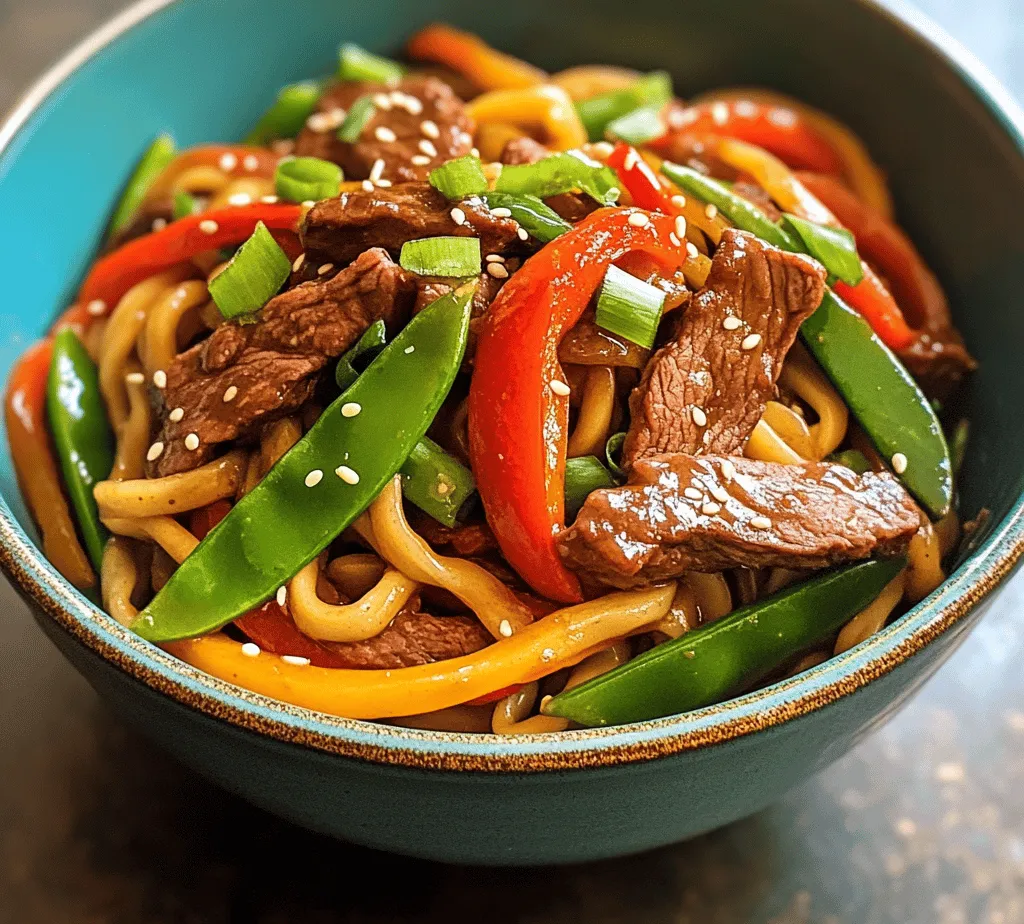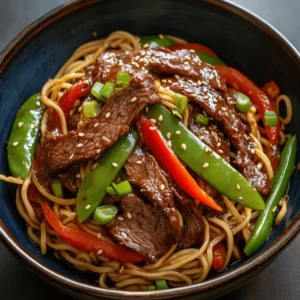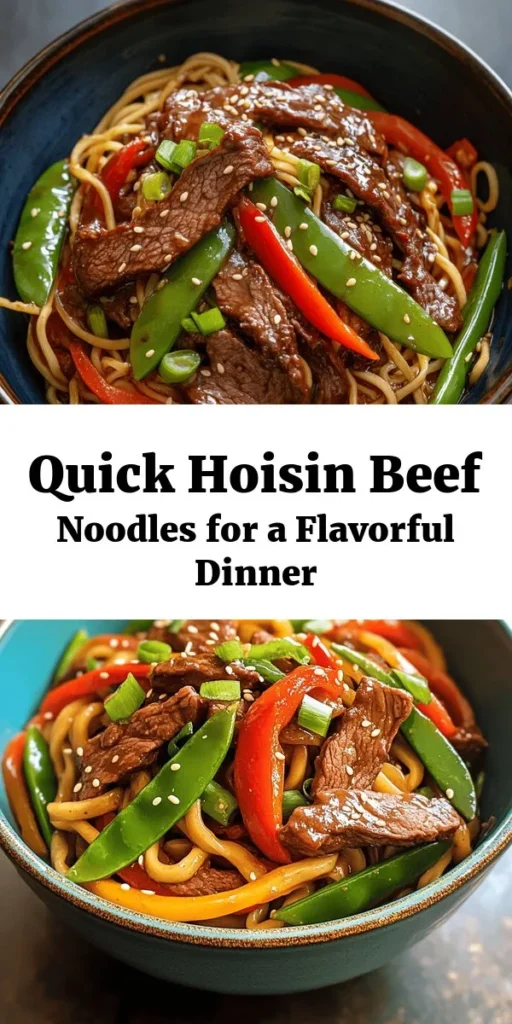Introduction
In the world of quick and satisfying meals, Hoisin Beef Noodles stand out as a delightful fusion of flavors and textures. This dish combines tender flank steak with vibrant vegetables and a rich, savory hoisin sauce, making it an ideal choice for a weeknight dinner or any occasion when you’re craving something delicious yet uncomplicated. With its roots deeply embedded in Asian cuisine, Hoisin Beef Noodles encapsulate the essence of balance and harmony that characterizes many traditional dishes.
As we explore this recipe, we will dive into the ingredients that make it special, the preparation methods that enhance its flavors, and the cultural significance of each component. Whether you are a seasoned cook or a beginner looking to expand your culinary repertoire, this dish promises a satisfying cooking experience and a meal that will impress family and friends alike.
Understanding Hoisin Sauce and Its Role in the Recipe
The Essence of Hoisin Sauce
Hoisin sauce is a staple in many Asian kitchens, renowned for its thick, syrupy consistency and deep, complex flavor profile. Originating from Southern China, this sauce has become a beloved ingredient across various Asian cuisines. Its name, which translates to “sea food,” is somewhat misleading, as it is not primarily used in seafood dishes but rather serves as a versatile condiment and cooking ingredient.
The flavor profile of hoisin sauce is a delightful combination of sweetness, saltiness, and umami. This unique blend makes it an essential component in many dishes, imparting richness and depth. The sweetness comes from sugar and fermented soybeans, while the saltiness is derived from soy sauce and sometimes the addition of garlic or vinegar. The umami notes elevate the dish, making it savory and satisfying.
Why Hoisin Sauce is Essential in Hoisin Beef Noodles
In the context of Hoisin Beef Noodles, hoisin sauce plays a pivotal role. It not only enhances the flavor of the beef but also complements the freshness of the vegetables. When cooked, the sauce caramelizes slightly, creating a beautiful glaze that coats the noodles and ingredients, tying the dish together beautifully.
The richness of hoisin sauce brings out the best in flank steak, a cut that is known for its robust flavor and tenderness when prepared correctly. Additionally, the sauce harmonizes with crunchy vegetables, like bell peppers and snap peas, allowing each bite to deliver a balanced taste experience. The result is a dish that is not only visually appealing but also a symphony of flavors that dance on the palate.
Ingredients Breakdown
Key Ingredients for Hoisin Beef Noodles
To create the perfect Hoisin Beef Noodles, you will need a selection of fresh and high-quality ingredients. Here’s a breakdown of the main components:
1. Flank Steak: This cut of beef is lean yet flavorful, making it ideal for stir-frying. It benefits greatly from marination, which enhances its tenderness and infuses it with flavor. Flank steak is also a good source of protein, iron, and several essential vitamins, making it a nutritious choice for your meal.
2. Egg Noodles: These noodles are the foundation of the dish, providing a satisfying base that absorbs the sauce beautifully. When cooked to perfection, they offer a chewy texture that complements the tender beef and crisp vegetables.
3. Fresh Vegetables: Colorful bell peppers and snap peas not only contribute to the visual appeal of the dish but also add crunch and nutritional value. Bell peppers are rich in vitamins A and C, while snap peas provide fiber and essential nutrients.
4. Hoisin Sauce: As discussed earlier, this sauce is the star of the dish. It brings a sweet and savory element that elevates the overall flavor profile.
5. Soy Sauce: This common Asian condiment adds depth and saltiness, enhancing the umami flavors present in the dish. It works in tandem with hoisin sauce to create a balanced sauce that coats the noodles and beef.
6. Oyster Sauce: Adding another layer of complexity, oyster sauce brings a rich, savory flavor that complements the other sauces. It’s particularly effective in stir-fried dishes, making it a great addition to Hoisin Beef Noodles.
7. Sesame Oil: A few drops of sesame oil can go a long way in enhancing the dish’s aroma and flavor. Its nutty, toasty notes provide a lovely finish to the noodles.
Creating Balance with Sauces
In cooking, balance is key, especially when it comes to flavors. The combination of hoisin sauce, soy sauce, and oyster sauce creates a layered taste experience that is both satisfying and complex. Each sauce plays its part:
– Hoisin Sauce: The primary ingredient that brings sweetness and richness.
– Soy Sauce: Enhances umami and adds saltiness.
– Oyster Sauce: Contributes a deeper savory flavor that rounds out the dish.
Additionally, the inclusion of sesame oil at the end of the cooking process adds an aromatic quality that elevates the dish, making it not only delicious but also enticing to the senses.
Step-by-Step Preparation Guide
Cooking the Noodles
The first step in preparing Hoisin Beef Noodles is cooking the egg noodles. Achieving the perfect noodle texture is crucial, as it sets the foundation for the entire dish. Here are some essential tips to ensure your noodles turn out just right:
1. Choose the Right Noodles: Opt for fresh egg noodles if possible, as they have a superior texture compared to dried noodles. If using dried noodles, ensure they are of good quality.
2. Salt the Water: When boiling water for the noodles, be sure to add a generous amount of salt. This not only flavors the noodles but also helps to enhance their overall taste.
3. Cooking Time: Follow the package instructions for cooking time, but be sure to taste the noodles a minute or two before the recommended time to ensure they are cooked al dente. Overcooked noodles can become mushy and unappetizing.
4. Drain and Rinse: Once cooked, drain the noodles and rinse them under cold water to stop the cooking process. This will help maintain their texture and prevent them from sticking together.
Marinating the Beef
While the noodles are cooking, it’s time to prepare the flank steak. Marinating the beef is essential for enhancing its flavor and tenderness. Here’s how to do it effectively:
1. Slice the Beef: Begin by slicing the flank steak against the grain into thin strips. This will help break down the muscle fibers, making the beef more tender.
2. Prepare the Marinade: In a bowl, combine hoisin sauce, soy sauce, and a splash of sesame oil. You can also add minced garlic or ginger for an extra flavor boost.
3. Marinating Time: Place the sliced beef in the marinade, ensuring all pieces are well-coated. Allow it to marinate for at least 15-30 minutes. For optimal results, marinate for 1-2 hours in the refrigerator. This longer marination time allows the flavors to penetrate the meat, resulting in a more flavorful dish.
Cooking Techniques for Optimal Flavor
Once the noodles are prepared and the beef is marinated, you are ready to cook the dish. Stir-frying is the ideal cooking method for Hoisin Beef Noodles, as it allows for quick cooking while preserving the freshness and crunch of the vegetables. Here’s how to achieve the best results:
1. Heat the Pan: Start by heating a wok or a large skillet over high heat. A well-seasoned cast iron skillet or a non-stick pan works well for this purpose. Ensure the pan is hot before adding any ingredients.
2. Cook the Beef: Add a drizzle of vegetable oil to the hot pan and allow it to heat up. Quickly add the marinated beef in a single layer, ensuring not to overcrowd the pan. Searing the beef in batches, if necessary, will help achieve a nice browning and prevent steaming.
3. Stir-Fry: Cook the beef for 2-3 minutes, turning occasionally until browned and just cooked through. Overcooking can lead to tough beef, so keep a close eye on it.
4. Add Vegetables: Once the beef is cooked, remove it from the pan and set it aside. In the same pan, add the bell peppers and snap peas, stir-frying them for a couple of minutes until they are crisp-tender but still vibrant in color.
5. Combine Ingredients: Add the cooked egg noodles and the beef back to the pan. Pour in any remaining marinade and a splash of oyster sauce, tossing everything together to combine. Ensure the noodles are evenly coated in the sauce.
6. Final Touches: Drizzle a little sesame oil over the top for added flavor, and toss everything one last time to ensure even distribution.
This careful approach to cooking will result in a dish that is rich in flavor, with perfectly tender beef, flavorful noodles, and crunchy vegetables, all enveloped in a delicious hoisin sauce.
As you prepare to serve your Hoisin Beef Noodles, get ready to impress your family and friends with this delightful dish that embodies the spirit of Asian cuisine. Stay tuned for the next part of this article, where we’ll explore additional tips for achieving the best results and answer some common questions about this mouthwatering recipe.

Sautéing Garlic and Ginger: The Aromatic Foundation
The journey to creating the perfect Hoisin Beef Noodles begins with the essential aromatic foundation: garlic and ginger. These two ingredients not only enhance the flavor profile but also add depth to the overall dish. Start by heating a tablespoon of vegetable oil in a large wok or skillet over medium heat. Once the oil is shimmering, add minced garlic (about 3 cloves) and grated ginger (1 tablespoon) to the pan. Sauté these aromatics for about 30 seconds until they become fragrant, being careful not to let them burn. The goal is to release their essential oils, setting the stage for the rich flavors to follow.
Stir-Frying Tips for Beef and Vegetables: Maintaining Texture
Next, it’s time to add in the beef and vegetables. For this recipe, thinly sliced flank steak (around 1 pound) works beautifully, as it is tender and absorbs flavors well. Before adding the beef, ensure that the pan is hot enough; this helps to sear the meat quickly, locking in juices and maintaining tenderness. Stir-fry the beef for about 3-4 minutes until it is browned but not fully cooked through. Remove the beef from the pan and set it aside.
Now, it’s time to add the vegetables. Common choices include bell peppers, broccoli, and snap peas, but feel free to get creative with seasonal vegetables. Stir-fry the veggies for about 2-3 minutes, ensuring they remain crisp and vibrant. The key here is to maintain a high heat to achieve that coveted stir-fried texture. Once the vegetables are tender yet still have a snap, return the beef to the pan, combining everything together.
Combining Ingredients for the Perfect Dish
Techniques for Tossing Noodles with Beef and Vegetables
With the beef and vegetables perfectly cooked, it’s time to introduce the star of the show: the noodles. Prepare your noodles of choice (egg noodles or rice noodles are popular options) according to the package instructions, then drain and add them directly into the wok.
To effectively toss the noodles with the beef and vegetables, use a pair of tongs or two spatulas. Start by gently folding the noodles into the mixture, ensuring they are evenly distributed. Incorporate the hoisin sauce (about 1/3 cup) at this stage, allowing it to coat the noodles and impart its sweet and savory flavor throughout the dish. Continue to stir-fry everything together for another minute or two, ensuring that the noodles are heated through and all ingredients are well combined.
Importance of Seasoning to Taste
As you combine the ingredients, it’s essential to taste and adjust the seasoning. Depending on your preference, you might want to add a splash of soy sauce for additional saltiness or a pinch of red pepper flakes for a hint of heat. Remember, the balance of flavors is key to a delicious dish, so don’t hesitate to tweak the seasonings until it suits your palate.
Serving Suggestions
Presentation Ideas for Hoisin Beef Noodles
Once your Hoisin Beef Noodles are ready, presentation plays a crucial role in elevating the meal experience. Start by transferring the noodles to a large serving bowl or individual plates. A vibrant plate will enhance the visual appeal of the dish. For an added touch, you can create a small well in the center of the noodles and place a handful of fresh herbs, like cilantro or basil, to add color and freshness.
Tips for Garnishing with Green Onions and Sesame Seeds
To finish off, garnish your Hoisin Beef Noodles with finely sliced green onions and a sprinkle of sesame seeds. These toppings not only add a pop of color but also provide a delightful crunch. For an extra layer of flavor, consider drizzling a touch of sesame oil over the dish just before serving.
Plating Suggestions for an Appetizing Look
When plating, consider using a wide, shallow bowl which allows the colorful ingredients to shine. Arrange the noodles in a nest-like fashion and layer the beef and vegetables on top. This method creates an inviting look, making the dish even more enticing.
Pairing Ideas
Recommended Side Dishes to Complement Hoisin Beef Noodles
To create a well-rounded meal, consider pairing your Hoisin Beef Noodles with a light side dish. A simple cucumber salad dressed in rice vinegar and sesame oil can provide a refreshing contrast to the richness of the noodles. Alternatively, steamed dumplings or spring rolls can make for a delightful accompaniment, adding another layer of texture to your dining experience.
Beverage Pairings that Enhance the Meal Experience
Beverage choices can further enhance the flavors of your meal. For a non-alcoholic option, iced green tea or a light citrus soda can refresh the palate. If you prefer an alcoholic beverage, consider serving your noodles with a crisp lager or a light white wine, such as a Sauvignon Blanc, which complements the savory notes of the hoisin sauce beautifully.
Cultural Context of Hoisin Beef Noodles
The Origins of Hoisin Beef Dishes
Hoisin sauce, a key ingredient in this dish, has deep roots in Chinese cuisine. Traditionally used as a dipping sauce, its sweet and savory profile has made it a versatile component in various recipes. Originating from the southern regions of China, hoisin sauce is made from fermented soybeans, sugar, vinegar, and spices, creating a rich flavor that pairs beautifully with meats.
Regional variations of beef noodle dishes can be found throughout China, with each area showcasing its unique interpretations. In some regions, the noodles are served in a broth, while others prefer a stir-fried or dry preparation, highlighting the versatility of this dish.
The Global Appeal of Hoisin Beef Noodles
Hoisin Beef Noodles have transcended cultural boundaries, becoming popular in various international cuisines. From Asian fusion restaurants to home kitchens worldwide, the dish is celebrated for its bold flavors and satisfying textures. Its adaptability allows cooks to modify ingredients based on local availability, making it a beloved option for many food enthusiasts.
Nutritional Analysis of Hoisin Beef Noodles
Caloric Breakdown
Understanding the nutritional content of your food can help you make informed dietary choices. A typical serving of Hoisin Beef Noodles contains approximately 450-600 calories, depending on the specific ingredients used and portion sizes.
Analysis of Macronutrients: Proteins, Fats, and Carbohydrates
In terms of macronutrients, you can expect about 30-35 grams of protein, primarily from the beef, along with 15-20 grams of fat and around 50-70 grams of carbohydrates from the noodles. This dish offers a satisfying balance of nutrients, making it a fulfilling meal option.
Health Benefits of the Ingredients
Incorporating fresh vegetables into your Hoisin Beef Noodles not only adds color but also boosts the nutritional value of the dish. Vegetables such as bell peppers and broccoli are rich in vitamins, minerals, and antioxidants, promoting overall health. Using lean cuts of beef, like flank steak, provides high-quality protein while keeping fat content in check.
Conclusion
Hoisin Beef Noodles is more than just a meal; it is a celebration of flavors and cultures coming together in one dish. Its combination of savory beef, fresh vegetables, and the unique sweetness of hoisin sauce creates a delightful dining experience that can be enjoyed any day of the week. By understanding the ingredients, preparation methods, and cultural significance, you can appreciate this dish even more. Whether you are a seasoned cook or a beginner, Hoisin Beef Noodles offers an accessible way to explore the rich world of Asian cuisine. Serve it to impress family and friends or savor it alone for a comforting meal. Embrace the flavors, and enjoy!



